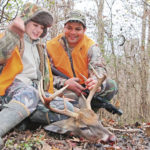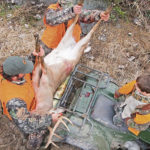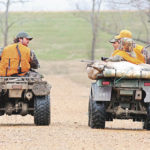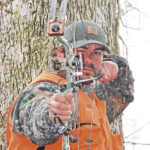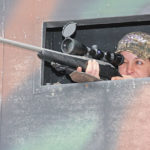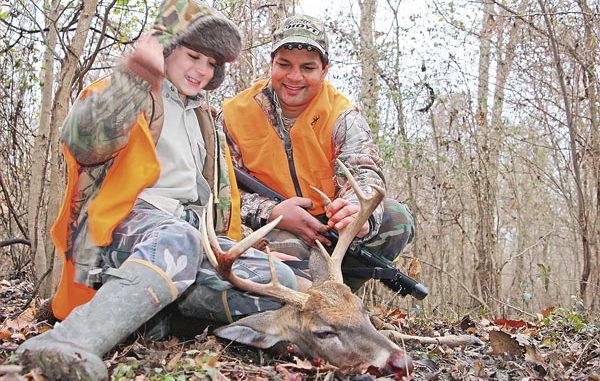
Keep your deer herd from getting nervous, and they’ll traipse around without a care in the world.
There comes a time in everybody’s life when some big lesson finally makes sense. It’s as if the light bulb going off above our heads is surrounded by a hundred angels all singing halleluiah. I’ve seen these epiphanies a few times on the faces of students who finally figured out the difference between a prepositional phrase and an infinitive.
However, it’s been a long time since I had one myself.
That was until I figured out that deer were watching me more closely than I was watching them. You want to talk about the proverbial switch being flipped! And to make matters worse, the more I learned about deer, the more I realized that they weren’t just watching me — they were patterning me.
Every slamming truck door, every whining ATV engine, every creaking ladder stand, every thing we do to alert deer to our presence just makes them that much harder to kill.
Kind of like wondering if the light really goes off when you shut the refrigerator door, hunters have always wondered what was going on before they got to their stands and after they left.
Trail cameras put an end to the wondering. Now we know when deer are using our plots or eating our corn, and more often than not, they do both when we’re nowhere to be found.
We all know deer hunters who could score while peeing with one hand and smoking a cigarette with the other, but those of us who don’t have horseshoes stuck where the sun don’t shine have to be a little more careful.
Take David Dellucci for instance. This former major league baseball player and Ol’ Miss standout who graduated from Catholic High in Baton Rouge spent many years standing out on the baseball diamond, but now he spends most of his time trying to blend in.
With so many hunters to drop off each morning, so many stands to manage and so many cameras to deploy and check, Dellucci has become the master of stealth as evidenced by the number of mature deer hanging on the wall of his hunting camp.
“We have deer that don’t even know hunters are in this world,” he said as a crowd of family and friends gathered around to listen. “These deer are extremely comfortable. Everybody who comes here makes the comment that our deer are very relaxed and not skittish. I’ve hunted places where if a car door slams, the deer are out of sight in no time. That’s not the case here because we take precautions.”
In fact, Dellucci added that he didn’t believe his deer would ever pattern him or his hunters because of the great lengths to which they go to make sure their scent is hidden, that they are hiding and that they don’t overhunt an area.
Dellucci’s insistence that all of his guests behave in such a way as to not unnecessarily spook deer on his property was made clear at our first meeting. He told me that I had to pass a written test, a shooting test and a videography test before he could drop me off at a blind.
Good thing I didn’t have to pass the smell test because I would have failed thanks to a greasy fast-food hamburger that made an emergency exit just moments before. According to Dellucci, I wouldn’t have had to worry about it anyway because he places wind direction at the forefront of his stealth strategies.
“Although it’s a little frustrating, and you don’t get to utilize sometimes your best stands due to wind direction, it’s very rewarding in the end,” he explained. “There are times that a hot stand with the wrong wind we won’t even go to it.”
Most hunters keep wind direction in mind, but too many wind up hunting a stand in the wrong wind just because it’s the only day they have to hunt. Take a stand on the south side of a food plot for example. This is a perfect stand for hunting with a north wind, but it would be horrible with a south wind.
A hunter who has been waiting all week to get in his stand sees south winds in the forecast for Saturday. Knowing he’s not hunting under ideal conditions, he climbs in anyway only to get busted a little later by a wary old doe that sniffed him out — strike one.
Although Dellucci doesn’t believe it’s nearly as important as hunting the right stand for a given wind direction because he’s still going to put out human scent, he strives to eliminate as much scent as he can.
Take his giant mudroom for instance. Before hunters enter the lodging part of the camp, they take off all their hunting clothes, boots and guns and store them in this room. This way the bacon and boudin smells of the living side don’t permeate the clothing or gear and inadvertently get carried to the stand.
Aside from smell, Dellucci says that deer are also totally in tune with sound. In other words, deer know what sounds are normal and what sounds aren’t. That’s why tractors and passing trucks don’t send most deer into a state of panic.
“They hear tractors and trucks all the time,” Dellucci insisted. “But that four-wheeler engine, that high-pitch engine, will spook a deer faster than anything. And they can hear a four-wheeler engine coming for miles and miles. We have four-wheelers, and we use them when we have to, but we move around the property on carts for the most part.”
Dellucci has driven his cart right by deer that do nothing more than pick up their heads and watch them go by. Put yourself in the place of a deer for a moment. You’ve been moving around freely for six or seven months without having to worry about much of anything.
Then, all of a sudden, like a swarm of angry African killer bees, buzzing engines invade your territory. You’ve heard the tractors all summer long. Trucks don’t bother you because they pass on the road every day.
But this buzzing, whining engine sound, it’s something that comes around only a few months of the year and the last time you heard it, you lost a few of your closest friends.
If you break out your four-wheeler only during deer season, you can bet the deer just went ahead in the count and you’re now sitting at strike two.
This is also why Dellucci positions his stands on access roads throughout his property. Deer feeding in food plots get used to non-threatening activity going up and down the roads in the form of tractors and carts. Therefore, he can get hunters in and out of stands without spooking deer.
“One of my philosophies is that I don’t put stands on or near trails,” he added. “I would rather you see a buck at 50 yards and not get a shot on him than to be right on top of that trail and have him spook because he sees or hears you. If you don’t spook him, you’ve got all year for that deer to eventually follow a doe or get off his trail and come right under your stand. If you spook him more than a couple times on a trail, he’ll never come back.”
Besides keeping down smell and sound, Dellucci also works hard to keep down the shooting. It’s not that he doesn’t want friends and family shooting deer. Rather, it’s that he wants them shooting deer as quietly as they can. That means most hunters who climb into his stands carry a bow and a rifle.
“We do that for several reasons,” Dellucci continued. “Bowhunting is the ultimate challenge, and everybody who hunts here loves to bowhunt. But we have stands that are set up where you can see a long way, and during the rut, I don’t think it’s fair for somebody to miss out on the opportunity at the buck of a lifetime because they have a bow and are limited to 40 yards or closer.”
In other words, Dellucci and his guests don’t see the challenge in shooting a deer with a rifle at 25 yards. Therefore, most of the deer they shoot are low-impact bow kills that don’t cause other deer to so much as blink an eye. But they keep the rifle close in case they need it for a long shot at a monster deer or the occasional wild hog or coyote.
“We don’t go in there and blast it up,” Dellucci said. “Except for the young’uns, we try to shoot all does with our bows. Rarely do we hear the guns going off. That’s just another way we try to keep the place calm and quiet. Anything we can do to keep our deer relaxed and moving around freely is worth the effort.”
Dellucci routinely hunts up to 7, 8, and even 9 or 10 hunters on his property. Imagine if all of those hunters shot deer with their rifles all during the same weekend. One or two shots won’t make much of a difference, but if those shots keep booming through the woods, they are going to put the deer on guard.
For Dellucci and his guests, that would be strike three.
And as he learned on his first day of little-league baseball, strike three means you’re out.
His stealth tactics allow him to work the count and stay alive all season long.
